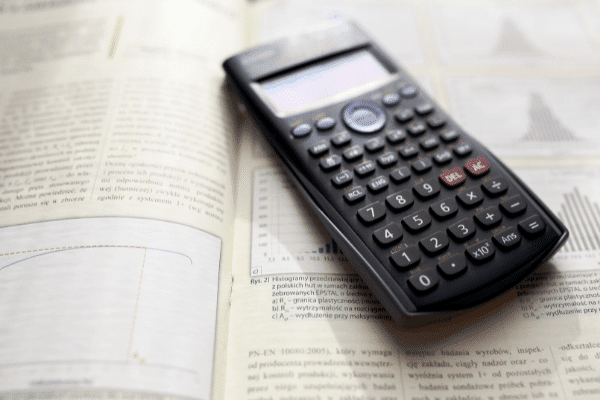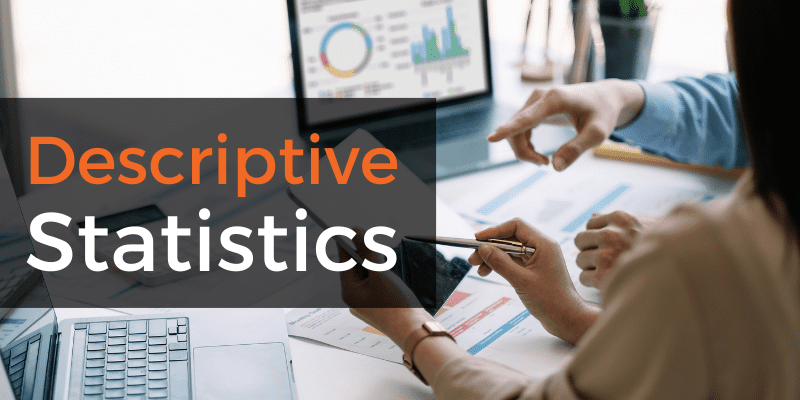
Want to create or adapt books like this? Learn more about how Pressbooks supports open publishing practices.
Quantitative Data Analysis

9 Presenting the Results of Quantitative Analysis
Mikaila Mariel Lemonik Arthur
This chapter provides an overview of how to present the results of quantitative analysis, in particular how to create effective tables for displaying quantitative results and how to write quantitative research papers that effectively communicate the methods used and findings of quantitative analysis.
Writing the Quantitative Paper
Standard quantitative social science papers follow a specific format. They begin with a title page that includes a descriptive title, the author(s)’ name(s), and a 100 to 200 word abstract that summarizes the paper. Next is an introduction that makes clear the paper’s research question, details why this question is important, and previews what the paper will do. After that comes a literature review, which ends with a summary of the research question(s) and/or hypotheses. A methods section, which explains the source of data, sample, and variables and quantitative techniques used, follows. Many analysts will include a short discussion of their descriptive statistics in the methods section. A findings section details the findings of the analysis, supported by a variety of tables, and in some cases graphs, all of which are explained in the text. Some quantitative papers, especially those using more complex techniques, will include equations. Many papers follow the findings section with a discussion section, which provides an interpretation of the results in light of both the prior literature and theory presented in the literature review and the research questions/hypotheses. A conclusion ends the body of the paper. This conclusion should summarize the findings, answering the research questions and stating whether any hypotheses were supported, partially supported, or not supported. Limitations of the research are detailed. Papers typically include suggestions for future research, and where relevant, some papers include policy implications. After the body of the paper comes the works cited; some papers also have an Appendix that includes additional tables and figures that did not fit into the body of the paper or additional methodological details. While this basic format is similar for papers regardless of the type of data they utilize, there are specific concerns relating to quantitative research in terms of the methods and findings that will be discussed here.
In the methods section, researchers clearly describe the methods they used to obtain and analyze the data for their research. When relying on data collected specifically for a given paper, researchers will need to discuss the sample and data collection; in most cases, though, quantitative research relies on pre-existing datasets. In these cases, researchers need to provide information about the dataset, including the source of the data, the time it was collected, the population, and the sample size. Regardless of the source of the data, researchers need to be clear about which variables they are using in their research and any transformations or manipulations of those variables. They also need to explain the specific quantitative techniques that they are using in their analysis; if different techniques are used to test different hypotheses, this should be made clear. In some cases, publications will require that papers be submitted along with any code that was used to produce the analysis (in SPSS terms, the syntax files), which more advanced researchers will usually have on hand. In many cases, basic descriptive statistics are presented in tabular form and explained within the methods section.
The findings sections of quantitative papers are organized around explaining the results as shown in tables and figures. Not all results are depicted in tables and figures—some minor or null findings will simply be referenced—but tables and figures should be produced for all findings to be discussed at any length. If there are too many tables and figures, some can be moved to an appendix after the body of the text and referred to in the text (e.g. “See Table 12 in Appendix A”).
Discussions of the findings should not simply restate the contents of the table. Rather, they should explain and interpret it for readers, and they should do so in light of the hypothesis or hypotheses that are being tested. Conclusions—discussions of whether the hypothesis or hypotheses are supported or not supported—should wait for the conclusion of the paper.
Creating Effective Tables
When creating tables to display the results of quantitative analysis, the most important goals are to create tables that are clear and concise but that also meet standard conventions in the field. This means, first of all, paring down the volume of information produced in the statistical output to just include the information most necessary for interpreting the results, but doing so in keeping with standard table conventions. It also means making tables that are well-formatted and designed, so that readers can understand what the tables are saying without struggling to find information. For example, tables (as well as figures such as graphs) need clear captions; they are typically numbered and referred to by number in the text. Columns and rows should have clear headings. Depending on the content of the table, formatting tools may need to be used to set off header rows/columns and/or total rows/columns; cell-merging tools may be necessary; and shading may be important in tables with many rows or columns.
Here, you will find some instructions for creating tables of results from descriptive, crosstabulation, correlation, and regression analysis that are clear, concise, and meet normal standards for data display in social science. In addition, after the instructions for creating tables, you will find an example of how a paper incorporating each table might describe that table in the text.
Descriptive Statistics
When presenting the results of descriptive statistics, we create one table with columns for each type of descriptive statistic and rows for each variable. Note, of course, that depending on level of measurement only certain descriptive statistics are appropriate for a given variable, so there may be many cells in the table marked with an — to show that this statistic is not calculated for this variable. So, consider the set of descriptive statistics below, for occupational prestige, age, highest degree earned, and whether the respondent was born in this country.
To display these descriptive statistics in a paper, one might create a table like Table 2. Note that for discrete variables, we use the value label in the table, not the value.
If we were then to discuss our descriptive statistics in a quantitative paper, we might write something like this (note that we do not need to repeat every single detail from the table, as readers can peruse the table themselves):
This analysis relies on four variables from the 2021 General Social Survey: occupational prestige score, age, highest degree earned, and whether the respondent was born in the United States. Descriptive statistics for all four variables are shown in Table 2. The median occupational prestige score is 47, with a range from 16 to 80. 50% of respondents had occupational prestige scores scores between 35 and 59. The median age of respondents is 53, with a range from 18 to 89. 50% of respondents are between ages 37 and 66. Both variables have little skew. Highest degree earned ranges from less than high school to a graduate degree; the median respondent has earned an associate’s degree, while the modal response (given by 39.8% of the respondents) is a high school degree. 88.8% of respondents were born in the United States.
Crosstabulation
When presenting the results of a crosstabulation, we simplify the table so that it highlights the most important information—the column percentages—and include the significance and association below the table. Consider the SPSS output below.
Table 4 shows how a table suitable for include in a paper might look if created from the SPSS output in Table 3. Note that we use asterisks to indicate the significance level of the results: * means p < 0.05; ** means p < 0.01; *** means p < 0.001; and no stars mean p > 0.05 (and thus that the result is not significant). Also note than N is the abbreviation for the number of respondents.
If we were going to discuss the results of this crosstabulation in a quantitative research paper, the discussion might look like this:
A crosstabulation of respondent’s class identification and their highest degree earned, with class identification as the independent variable, is significant, with a Spearman correlation of 0.419, as shown in Table 4. Among lower class and working class respondents, more than 50% had earned a high school degree. Less than 20% of poor respondents and less than 40% of working-class respondents had earned more than a high school degree. In contrast, the majority of middle class and upper class respondents had earned at least a bachelor’s degree. In fact, 50% of upper class respondents had earned a graduate degree.
Correlation
When presenting a correlating matrix, one of the most important things to note is that we only present half the table so as not to include duplicated results. Think of the line through the table where empty cells exist to represent the correlation between a variable and itself, and include only the triangle of data either above or below that line of cells. Consider the output in Table 5.
Table 6 shows what the contents of Table 5 might look like when a table is constructed in a fashion suitable for publication.
If we were to discuss the results of this bivariate correlation analysis in a quantitative paper, the discussion might look like this:
Bivariate correlations were run among variables measuring age, occupational prestige, the highest year of school respondents completed, and family income in constant 1986 dollars, as shown in Table 6. Correlations between age and highest year of school completed and between age and family income are not significant. All other correlations are positive and significant at the p<0.001 level. The correlation between age and occupational prestige is weak; the correlations between income and occupational prestige and between income and educational attainment are moderate, and the correlation between education and occupational prestige is strong.
To present the results of a regression, we create one table that includes all of the key information from the multiple tables of SPSS output. This includes the R 2 and significance of the regression, either the B or the beta values (different analysts have different preferences here) for each variable, and the standard error and significance of each variable. Consider the SPSS output in Table 7.
The regression output in shown in Table 7 contains a lot of information. We do not include all of this information when making tables suitable for publication. As can be seen in Table 8, we include the Beta (or the B), the standard error, and the significance asterisk for each variable; the R 2 and significance for the overall regression; the degrees of freedom (which tells readers the sample size or N); and the constant; along with the key to p/significance values.
If we were to discuss the results of this regression in a quantitative paper, the results might look like this:
Table 8 shows the results of a regression in which age, occupational prestige, and highest year of school completed are the independent variables and family income is the dependent variable. The regression results are significant, and all of the independent variables taken together explain 15.6% of the variance in family income. Age is not a significant predictor of income, while occupational prestige and educational attainment are. Educational attainment has a larger effect on family income than does occupational prestige. For every year of additional education attained, family income goes up on average by $3,988.545; for every one-unit increase in occupational prestige score, family income goes up on average by $522.887. [1]
- Choose two discrete variables and three continuous variables from a dataset of your choice. Produce appropriate descriptive statistics on all five of the variables and create a table of the results suitable for inclusion in a paper.
- Using the two discrete variables you have chosen, produce an appropriate crosstabulation, with significance and measure of association. Create a table of the results suitable for inclusion in a paper.
- Using the three continuous variables you have chosen, produce a correlation matrix. Create a table of the results suitable for inclusion in a paper.
- Using the three continuous variables you have chosen, produce a multivariate linear regression. Create a table of the results suitable for inclusion in a paper.
- Write a methods section describing the dataset, analytical methods, and variables you utilized in questions 1, 2, 3, and 4 and explaining the results of your descriptive analysis.
- Write a findings section explaining the results of the analyses you performed in questions 2, 3, and 4.
- Note that the actual numberical increase comes from the B values, which are shown in the SPSS output in Table 7 but not in the reformatted Table 8. ↵
Social Data Analysis Copyright © 2021 by Mikaila Mariel Lemonik Arthur and Roger Clark is licensed under a Creative Commons Attribution-NonCommercial-ShareAlike 4.0 International License , except where otherwise noted.
- [email protected]
- +1 646 475 7865
- REQUEST FOR CALL BACK
Reporting Your Quantitative Research Findings: Best Practices and Guidelines
Accurately and clearly reporting your quantitative research findings is key to the success and credibility of your study. A good report makes it easy for others to understand your research and build on it. However, many businesses struggle with documenting their findings, which can lead to gaps in their strategies. In this blog, we’ll share simple tips and guidelines for reporting your research results in a way that’s easy to read and understand.
Importance of Reporting Quantitative Research Findings Accurately
Accurate reporting of quantitative research findings is of utmost importance for several reasons. Let’s discuss some fundamentals of quantitative research :
- Verification and Replication : Accurate reporting allows other researchers to verify and replicate your study, which is essential for advancing scientific knowledge. Providing a clear quantitative report example helps in maintaining transparency in the research process.
- Transparency and Credibility : Accurate reporting ensures transparency and credibility by offering a detailed account of the methods, data analysis, and results obtained. This transparency is crucial for the integrity of quantitative research reports .
- Evidence-Based Decision Making : Well-reported findings enable policymakers, practitioners, and stakeholders to make informed decisions and take appropriate actions based on the data provided.
6 Key Components of a Quantitative Research Report
A comprehensive quantitative research guide typically includes six key components:
- Title Page : The title page provides essential information about the research, including the title, author(s), institutional affiliation, and contact details. It sets the tone for the report and introduces readers to the study.
- Abstract : The abstract is a concise summary of the research, offering a brief overview of the research question, methodology, key findings, and implications. It helps readers quickly grasp the essence of the study.
- Introduction : The introduction sets the context for the research, outlines the problem or research question, and provides a rationale for the study. It often includes a review of relevant literature and the research’s objectives and hypotheses.
- Methodology : This section details the research methods and techniques used, such as data collection, sampling procedures, and statistical analysis. It should be comprehensive and transparent to enable others to replicate the study. Utilizing quantitative data analysis services ensures that this section is robust and thorough.
- Results : In the results section, researchers present their quantitative findings using tables, figures, and statistical analyses. It should be organized logically, with clear headings and labels. Interpretations are typically minimal in this section.
- Discussion and Conclusion : This part discusses the implications of the findings, their relevance to the research question or hypothesis, and how they fit into the existing body of knowledge. The conclusion summarizes the key findings and provides a concise answer to the research question. Researchers may also suggest areas for future research in this section.
Guidelines for Writing Clear and Concise Summaries of Quantitative Findings
Writing clear and concise summaries of your quantitative findings is essential to ensure that readers can easily grasp the key insights of your research . Here are some guidelines to follow:
- Begin with an Overview : Start by providing a brief overview of the research question and objectives.
- Present Main Findings : Use descriptive statistics, such as means, percentages, or correlations, to present the main findings.
- Simplify the Language : Use clear and straightforward language to explain the results, avoiding jargon or technical terms as much as possible.
- Organize Logically : Organize the findings into logical sections or themes, making it easier for readers to navigate through the information.
- Highlight Significance : Emphasize the significance and implications of the findings, linking them back to the research question and objectives.
- Acknowledge Limitations : Summarize the limitations of the study, acknowledging any potential biases or weaknesses in the data or methodology.
- Suggest Future Research : Conclude by suggesting possible directions for future research or areas where further investigation is needed.
7 Best Practices for Organizing and Presenting Quantitative Data
Organizing and presenting quantitative data effectively is fundamental to the success of quantitative research, especially for a quantitative market research company . Here are seven best practices to consider:
- Clear Data Labels and Headings : Use descriptive labels and headings that clearly convey the content of tables, charts, or graphs. Make sure to include units of measurement where applicable.
- Consistent Formatting : Maintain consistent formatting throughout the report, including fonts, colors, and style. This consistency aids readability and ensures a professional look.
- Use Appropriate Visuals : Choose the right type of visual representation for your data, such as bar charts, pie charts, histograms, or scatterplots. Ensure that the chosen visual aids effectively convey the data’s message.
- Simplify Charts and Graphs : Avoid cluttered visuals by simplifying charts and graphs. Use appropriate scales and eliminate unnecessary gridlines, labels, or decorations.
- Meaningful Titles and Captions : Provide meaningful titles and captions for all visuals to guide the reader’s interpretation. Explain the significance of each chart or graph within the context of the research.
- Highlight Key Findings : Emphasize the most important findings of quantitative research by using different colors, bold text, or callout boxes. Direct the reader’s attention to critical data points.
- Provide Context and Interpretation : Don’t assume that the reader will automatically understand the data. Offer explanations, interpretations, and insights regarding the data. Relate the findings back to the research objectives and hypothesis.
Common Mistakes to Avoid When Reporting Quantitative Research Findings
While reporting your quantitative research findings, it is important to be aware of common mistakes that can undermine the clarity and accuracy of your report. Avoid the following pitfalls:
- Overcomplicating Language : Avoid using excessive jargon, making it difficult for readers to understand the findings.
- Lack of Context : Failing to provide sufficient context and background information can leave readers confused or uninformed.
- Presenting Raw Data : Presenting raw data without proper interpretation or analysis can lead readers to draw their own conclusions.
- Ignoring Limitations : Neglecting to acknowledge the limitations and potential biases of the study can undermine the credibility of the findings.
- Irrelevant Information : Including irrelevant or extraneous information can distract readers from the main findings.
- Formatting Errors : Failing to adhere to the formatting and style guidelines specified by the journal or publication can reduce the professionalism of your report.
- Ignoring Feedback : Ignoring feedback and suggestions from peers and reviewers can miss opportunities to improve the quality of your report.
Partner with the Best Quantitative Market Research Company
When conducting quantitative research, partnering with a reputable quantitative market research agency can greatly enhance the quality and impact of your findings. A professional research company possesses the expertise and resources to design robust research studies, collect high-quality data, and analyze the results accurately. By collaborating with Insight Opinion , you can ensure that your quantitative research report adheres to the best practices and guidelines discussed in this article, maximizing the value and relevance of your findings.
At Insight Opinion , we organize and present your data in a logical and accessible manner, incorporating tables and figures where appropriate. Our experts make sure that your quantitative research reports are well-received, helping you make data-driven decisions that drive your business forward.
Conclusion:
Accurately reporting quantitative research findings is a crucial aspect of the research process. By following the best practices outlined in this guide, you can ensure that your findings are clear, concise, and impactful. Remember, the goal is not just to present data but to tell a compelling story that adds value to the existing body of knowledge. Whether you are preparing a quantitative report example or working on a more comprehensive research project, adhering to these guidelines will enhance the credibility of your work and facilitate evidence-based decision-making. For those seeking professional assistance in this domain, Insight Opinion is your trusted partner in delivering high-quality quantitative data analysis services . Let us help you achieve your research goals with precision and clarity.
What are the key components of a quantitative research report?
A quantitative research report typically includes the title page, abstract, introduction, methodology, results, and discussion/conclusion.
Why is accurate reporting important in quantitative research?
Accurate reporting ensures transparency, allows for replication of the study, and enables evidence-based decision-making by stakeholders.
How can I effectively present quantitative data in my report?
Use clear labels, consistent formatting, appropriate visuals, and provide context and interpretation to make your data easily understandable.
What are common mistakes to avoid in quantitative research reporting?
Avoid overcomplicated language, insufficient context, presenting raw data without interpretation, and failing to acknowledge study limitations.
Why should I partner with a quantitative market research agency?
Partnering with a reputable agency ensures high-quality data collection, accurate analysis, and adherence to best practices in reporting your findings.
- Tags Quantitative Data Analysis Services , quantitative market research agency , quantitative market research company
Team Insights
- Quantitative Research
- Qualitative Research
- Global Panel
- Mystery Shopping
- Survey Audit
- Programming & Hosting
- Translation
- Data Processing & Analytics
- Online Community Building
Request for call back

🚀 Work With Us
Private Coaching
Language Editing
Qualitative Coding
✨ Free Resources
Templates & Tools
Short Courses
Articles & Videos
How To Write The Results/Findings Chapter
By: Derek Jansen (MBA) | Expert Reviewed By: Kerryn Warren (PhD) | July 2021

Overview: Quantitative Results Chapter
- What exactly the results chapter is
- What you need to include in your chapter
- How to structure the chapter
- Tips and tricks for writing a top-notch chapter
- Free results chapter template
What exactly is the results chapter?
The results chapter (also referred to as the findings or analysis chapter) is one of the most important chapters of your dissertation or thesis because it shows the reader what you’ve found in terms of the quantitative data you’ve collected. It presents the data using a clear text narrative, supported by tables, graphs and charts. In doing so, it also highlights any potential issues (such as outliers or unusual findings) you’ve come across.
But how’s that different from the discussion chapter?
Well, in the results chapter, you only present your statistical findings. Only the numbers, so to speak – no more, no less. Contrasted to this, in the discussion chapter , you interpret your findings and link them to prior research (i.e. your literature review), as well as your research objectives and research questions . In other words, the results chapter presents and describes the data, while the discussion chapter interprets the data.
Let’s look at an example.
In your results chapter, you may have a plot that shows how respondents to a survey responded: the numbers of respondents per category, for instance. You may also state whether this supports a hypothesis by using a p-value from a statistical test. But it is only in the discussion chapter where you will say why this is relevant or how it compares with the literature or the broader picture. So, in your results chapter, make sure that you don’t present anything other than the hard facts – this is not the place for subjectivity.
It’s worth mentioning that some universities prefer you to combine the results and discussion chapters. Even so, it is good practice to separate the results and discussion elements within the chapter, as this ensures your findings are fully described. Typically, though, the results and discussion chapters are split up in quantitative studies. If you’re unsure, chat with your research supervisor or chair to find out what their preference is.
⚡ GET THE FREE TEMPLATE ⚡
Fast-track your research with our award-winning Results Section Template .
Download Now 📂
What should you include in the results chapter?
Following your analysis, it’s likely you’ll have far more data than are necessary to include in your chapter. In all likelihood, you’ll have a mountain of SPSS or R output data, and it’s your job to decide what’s most relevant. You’ll need to cut through the noise and focus on the data that matters.
This doesn’t mean that those analyses were a waste of time – on the contrary, those analyses ensure that you have a good understanding of your dataset and how to interpret it. However, that doesn’t mean your reader or examiner needs to see the 165 histograms you created! Relevance is key.
How do I decide what’s relevant?
At this point, it can be difficult to strike a balance between what is and isn’t important. But the most important thing is to ensure your results reflect and align with the purpose of your study . So, you need to revisit your research aims, objectives and research questions and use these as a litmus test for relevance. Make sure that you refer back to these constantly when writing up your chapter so that you stay on track.

As a general guide, your results chapter will typically include the following:
- Some demographic data about your sample
- Reliability tests (if you used measurement scales)
- Descriptive statistics
- Inferential statistics (if your research objectives and questions require these)
- Hypothesis tests (again, if your research objectives and questions require these)
We’ll discuss each of these points in more detail in the next section.
Importantly, your results chapter needs to lay the foundation for your discussion chapter . This means that, in your results chapter, you need to include all the data that you will use as the basis for your interpretation in the discussion chapter.
For example, if you plan to highlight the strong relationship between Variable X and Variable Y in your discussion chapter, you need to present the respective analysis in your results chapter – perhaps a correlation or regression analysis.
Need a helping hand?
How do I write the results chapter?
There are multiple steps involved in writing up the results chapter for your quantitative research. The exact number of steps applicable to you will vary from study to study and will depend on the nature of the research aims, objectives and research questions . However, we’ll outline the generic steps below.
Step 1 – Revisit your research questions
The first step in writing your results chapter is to revisit your research objectives and research questions . These will be (or at least, should be!) the driving force behind your results and discussion chapters, so you need to review them and then ask yourself which statistical analyses and tests (from your mountain of data) would specifically help you address these . For each research objective and research question, list the specific piece (or pieces) of analysis that address it.
At this stage, it’s also useful to think about the key points that you want to raise in your discussion chapter and note these down so that you have a clear reminder of which data points and analyses you want to highlight in the results chapter. Again, list your points and then list the specific piece of analysis that addresses each point.
Next, you should draw up a rough outline of how you plan to structure your chapter . Which analyses and statistical tests will you present and in what order? We’ll discuss the “standard structure” in more detail later, but it’s worth mentioning now that it’s always useful to draw up a rough outline before you start writing (this advice applies to any chapter).
Step 2 – Craft an overview introduction
As with all chapters in your dissertation or thesis, you should start your quantitative results chapter by providing a brief overview of what you’ll do in the chapter and why . For example, you’d explain that you will start by presenting demographic data to understand the representativeness of the sample, before moving onto X, Y and Z.
This section shouldn’t be lengthy – a paragraph or two maximum. Also, it’s a good idea to weave the research questions into this section so that there’s a golden thread that runs through the document.

Step 3 – Present the sample demographic data
The first set of data that you’ll present is an overview of the sample demographics – in other words, the demographics of your respondents.
For example:
- What age range are they?
- How is gender distributed?
- How is ethnicity distributed?
- What areas do the participants live in?
The purpose of this is to assess how representative the sample is of the broader population. This is important for the sake of the generalisability of the results. If your sample is not representative of the population, you will not be able to generalise your findings. This is not necessarily the end of the world, but it is a limitation you’ll need to acknowledge.
Of course, to make this representativeness assessment, you’ll need to have a clear view of the demographics of the population. So, make sure that you design your survey to capture the correct demographic information that you will compare your sample to.
But what if I’m not interested in generalisability?
Well, even if your purpose is not necessarily to extrapolate your findings to the broader population, understanding your sample will allow you to interpret your findings appropriately, considering who responded. In other words, it will help you contextualise your findings . For example, if 80% of your sample was aged over 65, this may be a significant contextual factor to consider when interpreting the data. Therefore, it’s important to understand and present the demographic data.

Step 4 – Review composite measures and the data “shape”.
Before you undertake any statistical analysis, you’ll need to do some checks to ensure that your data are suitable for the analysis methods and techniques you plan to use. If you try to analyse data that doesn’t meet the assumptions of a specific statistical technique, your results will be largely meaningless. Therefore, you may need to show that the methods and techniques you’ll use are “allowed”.
Most commonly, there are two areas you need to pay attention to:
#1: Composite measures
The first is when you have multiple scale-based measures that combine to capture one construct – this is called a composite measure . For example, you may have four Likert scale-based measures that (should) all measure the same thing, but in different ways. In other words, in a survey, these four scales should all receive similar ratings. This is called “ internal consistency ”.
Internal consistency is not guaranteed though (especially if you developed the measures yourself), so you need to assess the reliability of each composite measure using a test. Typically, Cronbach’s Alpha is a common test used to assess internal consistency – i.e., to show that the items you’re combining are more or less saying the same thing. A high alpha score means that your measure is internally consistent. A low alpha score means you may need to consider scrapping one or more of the measures.
#2: Data shape
The second matter that you should address early on in your results chapter is data shape. In other words, you need to assess whether the data in your set are symmetrical (i.e. normally distributed) or not, as this will directly impact what type of analyses you can use. For many common inferential tests such as T-tests or ANOVAs (we’ll discuss these a bit later), your data needs to be normally distributed. If it’s not, you’ll need to adjust your strategy and use alternative tests.
To assess the shape of the data, you’ll usually assess a variety of descriptive statistics (such as the mean, median and skewness), which is what we’ll look at next.

Step 5 – Present the descriptive statistics
Now that you’ve laid the foundation by discussing the representativeness of your sample, as well as the reliability of your measures and the shape of your data, you can get started with the actual statistical analysis. The first step is to present the descriptive statistics for your variables.
For scaled data, this usually includes statistics such as:
- The mean – this is simply the mathematical average of a range of numbers.
- The median – this is the midpoint in a range of numbers when the numbers are arranged in order.
- The mode – this is the most commonly repeated number in the data set.
- Standard deviation – this metric indicates how dispersed a range of numbers is. In other words, how close all the numbers are to the mean (the average).
- Skewness – this indicates how symmetrical a range of numbers is. In other words, do they tend to cluster into a smooth bell curve shape in the middle of the graph (this is called a normal or parametric distribution), or do they lean to the left or right (this is called a non-normal or non-parametric distribution).
- Kurtosis – this metric indicates whether the data are heavily or lightly-tailed, relative to the normal distribution. In other words, how peaked or flat the distribution is.
A large table that indicates all the above for multiple variables can be a very effective way to present your data economically. You can also use colour coding to help make the data more easily digestible.
For categorical data, where you show the percentage of people who chose or fit into a category, for instance, you can either just plain describe the percentages or numbers of people who responded to something or use graphs and charts (such as bar graphs and pie charts) to present your data in this section of the chapter.
When using figures, make sure that you label them simply and clearly , so that your reader can easily understand them. There’s nothing more frustrating than a graph that’s missing axis labels! Keep in mind that although you’ll be presenting charts and graphs, your text content needs to present a clear narrative that can stand on its own. In other words, don’t rely purely on your figures and tables to convey your key points: highlight the crucial trends and values in the text. Figures and tables should complement the writing, not carry it .
Depending on your research aims, objectives and research questions, you may stop your analysis at this point (i.e. descriptive statistics). However, if your study requires inferential statistics, then it’s time to deep dive into those .

Step 6 – Present the inferential statistics
Inferential statistics are used to make generalisations about a population , whereas descriptive statistics focus purely on the sample . Inferential statistical techniques, broadly speaking, can be broken down into two groups .
First, there are those that compare measurements between groups , such as t-tests (which measure differences between two groups) and ANOVAs (which measure differences between multiple groups). Second, there are techniques that assess the relationships between variables , such as correlation analysis and regression analysis. Within each of these, some tests can be used for normally distributed (parametric) data and some tests are designed specifically for use on non-parametric data.
There are a seemingly endless number of tests that you can use to crunch your data, so it’s easy to run down a rabbit hole and end up with piles of test data. Ultimately, the most important thing is to make sure that you adopt the tests and techniques that allow you to achieve your research objectives and answer your research questions .
In this section of the results chapter, you should try to make use of figures and visual components as effectively as possible. For example, if you present a correlation table, use colour coding to highlight the significance of the correlation values, or scatterplots to visually demonstrate what the trend is. The easier you make it for your reader to digest your findings, the more effectively you’ll be able to make your arguments in the next chapter.

Step 7 – Test your hypotheses
If your study requires it, the next stage is hypothesis testing. A hypothesis is a statement , often indicating a difference between groups or relationship between variables, that can be supported or rejected by a statistical test. However, not all studies will involve hypotheses (again, it depends on the research objectives), so don’t feel like you “must” present and test hypotheses just because you’re undertaking quantitative research.
The basic process for hypothesis testing is as follows:
- Specify your null hypothesis (for example, “The chemical psilocybin has no effect on time perception).
- Specify your alternative hypothesis (e.g., “The chemical psilocybin has an effect on time perception)
- Set your significance level (this is usually 0.05)
- Calculate your statistics and find your p-value (e.g., p=0.01)
- Draw your conclusions (e.g., “The chemical psilocybin does have an effect on time perception”)
Finally, if the aim of your study is to develop and test a conceptual framework , this is the time to present it, following the testing of your hypotheses. While you don’t need to develop or discuss these findings further in the results chapter, indicating whether the tests (and their p-values) support or reject the hypotheses is crucial.

Step 8 – Provide a chapter summary
To wrap up your results chapter and transition to the discussion chapter, you should provide a brief summary of the key findings . “Brief” is the keyword here – much like the chapter introduction, this shouldn’t be lengthy – a paragraph or two maximum. Highlight the findings most relevant to your research objectives and research questions, and wrap it up.
Some final thoughts, tips and tricks
Now that you’ve got the essentials down, here are a few tips and tricks to make your quantitative results chapter shine:
- When writing your results chapter, report your findings in the past tense . You’re talking about what you’ve found in your data, not what you are currently looking for or trying to find.
- Structure your results chapter systematically and sequentially . If you had two experiments where findings from the one generated inputs into the other, report on them in order.
- Make your own tables and graphs rather than copying and pasting them from statistical analysis programmes like SPSS. Check out the DataIsBeautiful reddit for some inspiration.
- Once you’re done writing, review your work to make sure that you have provided enough information to answer your research questions , but also that you didn’t include superfluous information.
If you’ve got any questions about writing up the quantitative results chapter, please leave a comment below. If you’d like 1-on-1 assistance with your quantitative analysis and discussion, check out our hands-on coaching service , or book a free consultation with a friendly coach.

Learn More About Quantitative:

Triangulation: The Ultimate Credibility Enhancer
Triangulation is one of the best ways to enhance the credibility of your research. Learn about the different options here.

Inferential Statistics 101: Simple Explainer (With Examples)
Learn about the key concepts and tests within inferential statistics, including t-tests, ANOVA, chi-square, correlation and regression.

Descriptive Statistics 101: Simple Explainer (With Examples)
Learn about the key concepts and measures within descriptive statistics, including measures of central tendency and dispersion.

Validity & Reliability: Explained Simply
Learn about validity and reliability within the context of research methodology. Plain-language explainer video with loads of examples.

Research Design 101: Qualitative & Quantitative
Learn about research design for both qualitative and quantitative studies. Includes plain-language explanations and examples.
📄 FREE TEMPLATES
Research Topic Ideation
Proposal Writing
Literature Review
Methodology & Analysis
Academic Writing
Referencing & Citing
Apps, Tools & Tricks
The Grad Coach Podcast
Thank you. I will try my best to write my results.
Awesome content 👏🏾
this was great explaination
Submit a Comment Cancel reply
Your email address will not be published. Required fields are marked *
Save my name, email, and website in this browser for the next time I comment.
Submit Comment
- Print Friendly

Want to create or adapt books like this? Learn more about how Pressbooks supports open publishing practices.
20 16. Reporting quantitative results
Chapter outline.
- Reporting quantitative results (8 minute read time)
Content warning: Brief discussion of violence against women.
16.1 Reporting quantitative results
Learning objectives.
Learners will be able to…
- Execute a quantitative research report using key elements for accuracy and openness
So you’ve completed your quantitative analyses and are ready to report your results. We’re going to spend some time talking about what matters in quantitative research reports, but the very first thing to understand is this: openness with your data and analyses is key. You should never hide what you did to get to a particular conclusion and, if someone wanted to and could ethically access your data, they should be able to replicate more or less exactly what you did. While your quantitative report won’t have every single step you took to get to your conclusion, it should have plenty of detail so someone can get the picture.
Below, I’m going to take you through the key elements of a quantitative research report. This overview is pretty general and conceptual, and it will be helpful for you to look at existing scholarly articles that deal with quantitative research (like ones in your literature review) to see the structure applied. Also keep in mind that your instructor may want the sections broken out slightly differently; nonetheless, the content I outline below should be in your research report.
Introduction and literature review
These are what you’re working on building with your research proposal this semester. They should be included as part of your research report so that readers have enough information to evaluate your research for themselves. What’s here should be very similar to the introduction and literature review from your research proposal, where you described the literature relevant to the study you wanted to do. With your results in hand, though, you may find that you have to add information to the literature you wrote previously to help orient the reader of the report to important topics needed to understand the results of your study.
In this section, you should explicitly lay out your study design – for instance, if it was experimental, be specific about the type of experimental design. Discuss the type of sampling that you used, if that’s applicable to your project. You should also go into a general description of your data, including the time period, any exclusions you made from the original data set and the source – i.e., did you collect it yourself or was it secondary data? Next, talk about the specific statistical methods you used, like t- tests, Chi-square tests, or regression analyses. For descriptive statistics, you can be relatively general – you don’t need to say “I looked at means and medians,” for instance. You need to provide enough information here that someone could replicate what you did.
In this section, you should also discuss how you operationalized your variables. What did you mean when you asked about educational attainment – did you ask for a grade number, or did you ask them to pick a range that you turned into a category? This is key information for readers to understand your research. Remember when you were looking for ways to operationalize your variables? Be the kind of author who provides enough information on operationalization so people can actually understand what they did.
You’re going to run lots of different analyses to settle on what finally makes sense to get a result – positive or negative – for your study. For this section, you’re going to provide tables with descriptions of your sample, including, but not limited to, sample size, frequencies of sample characteristics like race and gender, levels of measurement, appropriate measures of central tendency, standard deviations and variances. Here you will also want to focus on the analyses you used to actually draw whatever conclusion you settled on, both descriptive and inferential (i.e., bivariate or multivariate).
The actual statistics you report depend entirely on the kind of statistical analysis you do. For instance, if you’re reporting on a logistic regression, it’s going to look a little different than reporting on an ANOVA. In the previous chapter, we provided links to open textbooks that detail how to conduct quantitative data analysis. You should look at these resources and consult with your research professor to help you determine what is expected in a report about the particular statistical method you used.
The important thing to remember here – as we mentioned above – is that you need to be totally transparent about your results, even and especially if they don’t support your hypothesis. There is value in a disproved hypothesis, too – you now know something about how the state of the world is not .
In this section, you’re going to connect your statistical results back to your hypothesis and discuss whether your results support your hypothesis or not. You are also going to talk about what the results mean for the larger field of study of which your research is a part, the implications of your findings if you’re evaluating some kind of intervention, and how your research relates to what is already out there in this field. When your research doesn’t pan out the way you expect, if you’re able to make some educated guesses as to why this might be (supported by literature if possible, but practice wisdom works too), share those as well.
Let’s take a minute to talk about what happens when your findings disprove your hypothesis or actually indicate something negative about the group you are studying. The discussion section is where you can contextualize “negative” findings. For example, say you conducted a study that indicated that a certain group is more likely to commit violent crime. Here, you have an opportunity to talk about why this might be the case outside of their membership in that group, and how membership in that group does not automatically mean someone will commit a violent crime. You can present mitigating factors, like a history of personal and community trauma. It’s extremely important to provide this relevant context so that your results are more difficult to use against a group you are studying in a way that doesn’t reflect your actual findings.
Limitations
In this section, you’re going to critique your own study. What are the advantages, disadvantages, and trade-offs of what you did to define and analyze your variables? Some questions you might consider include: What limits the study’s applicability to the population at large? Were there trade-offs you had to make between rigor and available data? Did the statistical analyses you used mean that you could only get certain types of results? What would have made the study more widely applicable or more useful for a certain group? You should be thinking about this throughout the analysis process so you can properly contextualize your results.
In this section, you may also consider discussing any threats to internal validity that you identified and whether you think you can generalize your research. Finally, if you used any measurement tools that haven’t been validated yet, discuss how this could have affected your results.
Significance and conclusions
Finally, you want to use the conclusions section to bring it full circle for your reader – why did this research matter? Talk about how it contributed to knowledge around the topic and how might it be used to further practice. Identify and discuss ethical implications of your findings for social workers and social work research. Finally, make sure to talk about the next steps for you, other researchers, or policy-makers based on your research findings.
Key Takeaways
- Your quantitative research report should provide the reader with transparent, replicable methods and put your research into the context of existing literature, real-world practice and social work ethics.
- Think about the research project you are building now. What could a negative finding be, and how might you provide your reader with context to ensure that you are not harming your study population?
The process of determining how to measure a construct that cannot be directly observed
Ability to say that one variable "causes" something to happen to another variable. Very important to assess when thinking about studies that examine causation such as experimental or quasi-experimental designs.
Graduate research methods in social work Copyright © 2020 by Matthew DeCarlo, Cory Cummings, Kate Agnelli is licensed under a Creative Commons Attribution-NonCommercial-ShareAlike 4.0 International License , except where otherwise noted.
Share This Book
Techniques for Reporting Quantitative Data
- First Online: 27 October 2022
Cite this chapter

- Md. Mahsin 4
3747 Accesses
A quantitative research report is a way of describing the completed study to other people. The findings are communicated through an oral presentation, a book, or a published paper. The report disseminates the results to research scientists or the policy decision-maker’s stakeholders. It is usually written in plain words so that a layperson can understand it, or it may be so highly technical so that the target audience can understand it easily. It organizes in many different ways depending on the intended audience and the author’s style. A rough sequence of steps for writing a quantitative research report describes in this section:
Specify a summary or abstract of the report to give a quick picture of the research article, thesis, review paper, conference proceeding, or in-depth analysis of a particular subject.
Define the research problem and discuss the methodology approach.
Present the results and findings and finally summarize the significance of the conclusions.
This is a preview of subscription content, log in via an institution to check access.
Access this chapter
Subscribe and save.
- Get 10 units per month
- Download Article/Chapter or eBook
- 1 Unit = 1 Article or 1 Chapter
- Cancel anytime
- Available as PDF
- Read on any device
- Instant download
- Own it forever
- Available as EPUB and PDF
- Compact, lightweight edition
- Dispatched in 3 to 5 business days
- Free shipping worldwide - see info
- Durable hardcover edition
Tax calculation will be finalised at checkout
Purchases are for personal use only
Institutional subscriptions
Similar content being viewed by others

Writing Quantitative Research Studies

What is “Qualitative” in Qualitative Research? Why the Answer Does not Matter but the Question is Important
Neuman, W. L., & Robson, K. (2012). Basics of social research: Qualitative and quantitative approaches.
Google Scholar
Download references
Author information
Authors and affiliations.
Department of Mathematics and Statistics, University of Calgary, 2500 University Drive NW, Calgary, Canada
You can also search for this author in PubMed Google Scholar
Corresponding author
Correspondence to Md. Mahsin .
Editor information
Editors and affiliations.
Centre for Family and Child Studies, Research Institute of Humanities and Social Sciences, University of Sharjah, Sharjah, United Arab Emirates
M. Rezaul Islam
Department of Development Studies, University of Dhaka, Dhaka, Bangladesh
Niaz Ahmed Khan
Department of Social Work, School of Humanities, University of Johannesburg, Johannesburg, South Africa
Rajendra Baikady
Rights and permissions
Reprints and permissions
Copyright information
© 2022 The Author(s), under exclusive license to Springer Nature Singapore Pte Ltd.
About this chapter
Mahsin, M. (2022). Techniques for Reporting Quantitative Data. In: Islam, M.R., Khan, N.A., Baikady, R. (eds) Principles of Social Research Methodology. Springer, Singapore. https://doi.org/10.1007/978-981-19-5441-2_17
Download citation
DOI : https://doi.org/10.1007/978-981-19-5441-2_17
Published : 27 October 2022
Publisher Name : Springer, Singapore
Print ISBN : 978-981-19-5219-7
Online ISBN : 978-981-19-5441-2
eBook Packages : Social Sciences Social Sciences (R0)
Share this chapter
Anyone you share the following link with will be able to read this content:
Sorry, a shareable link is not currently available for this article.
Provided by the Springer Nature SharedIt content-sharing initiative
- Publish with us
Policies and ethics
- Find a journal
- Track your research

IMAGES
VIDEO
COMMENTS
While this basic format is similar for papers regardless of the type of data they utilize, there are specific concerns relating to quantitative research in terms of the methods and findings that will be discussed here. Methods. In the methods section, researchers clearly describe the methods they used to obtain and analyze the data for their ...
Accurate reporting of quantitative research findings is of utmost importance for several reasons. Let’s discuss some fundamentals of quantitative research : Verification and Replication : Accurate reporting allows other researchers to verify and replicate your study, which is essential for advancing scientific knowledge.
Norris et al. Guidelines for Reporting Quantitative Methods structured exactly according to the section and subsection headers provided; depending on the particular approach to quantitative research, distinct catego-rization, ordering, and summarization or expansion of detail will be required.
Contrasted to this, in the discussion chapter, you interpret your findings and link them to prior research (i.e. your literature review), as well as your research objectives and research questions. In other words, the results chapter presents and describes the data, while the discussion chapter interprets the data.
Aug 30, 2022 · Reporting quantitative research results. If you conducted quantitative research, you’ll likely be working with the results of some sort of statistical analysis. Your results section should report the results of any statistical tests you used to compare groups or assess relationships between variables.
Dec 21, 2020 · The results section of a quantitative research paper is where you summarize your data and report the findings of any relevant statistical analyses. The APA manual provides rigorous guidelines for what to report in quantitative research papers in the fields of psychology, education, and other social sciences.
May 21, 2015 · Although recent surveys of L2 reporting practices have found that more researchers are including important data such as effect sizes, confidence intervals, reliability coefficients, research questions, a priori alpha levels, graphics, and so forth in their research reports, we call for further improvement so that research findings may build ...
Execute a quantitative research report using key elements for accuracy and openness So you’ve completed your quantitative analyses and are ready to report your results. We’re going to spend some time talking about what matters in quantitative research reports, but the very first thing to understand is this: openness with your data and ...
Jan 13, 2019 · Summarizing quantitative data and its effective presentation and discussion can be challenging for students and researchers. This chapter provides a framework for adequately reporting findings from quantitative analysis in a research study for those contemplating to...
Oct 27, 2022 · A quantitative research report is a way of describing the completed study to other people. The findings are communicated through an oral presentation, a book, or a published paper. The report disseminates the results to research scientists or the policy...